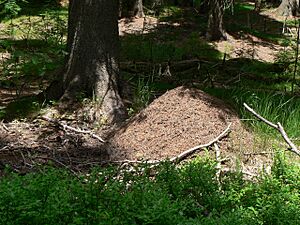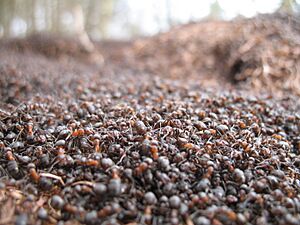Hairy wood ant facts for kids
Quick facts for kids Hairy wood ant |
|
|---|---|
 |
|
| F. lugubris worker form Russia | |
| Conservation status | |
|
LR/nt (IUCN2.2)
|
|
| Scientific classification |
The hairy wood ant, also known as Formica lugubris, lives in forests across northern Europe and Asia. These ants build large, dome-shaped nests from twigs and leaves. Thousands of worker ants and one or more queens live in these nests. Hairy wood ants look like other wood ants from the genus Formica. You can tell them apart by the tiny hairs around their eyes. Worker ants can grow up to 9 mm long. Queens are bigger, reaching about 12 mm in length.
Contents
Ant Behavior: How Hairy Wood Ants Live
Each ant can recognize others from its own colony by a special scent. This scent helps them know who belongs and who doesn't. If they meet ants from other colonies, they often see them as invaders. These intruders might be dragged into the nest. Fights between ants are common and usually end with one ant dying.
Sometimes, ants from different colonies of the same species might fight. But in places where nests have many queens, ants from nearby nests often get along. When a fight starts, ants stand tall with their mouths open. This is their way of showing they are ready to fight. Ants from the same colony do not act aggressively towards each other. Worker ants can also release special scents called pheromones. These scents warn others about danger nearby.
Reproduction and Life Cycle
Hairy wood ants usually mate in June. Female ants with wings release a scent to attract males. The male and female ants then fly off into the forest to mate on the ground. They usually find a spot away from other worker ants. Not all ants can reproduce. Only the larger males and females have wings and can mate. After mating, the male ant dies. The female ant loses her wings and starts a new colony.
Fertilized queens can sometimes take over the nests of other ant species, like Serviformica ants. The queen lands on a Serviformica nest and finds their queen. She then kills the Serviformica queen and takes her place. The Serviformica worker ants will then care for the new queen's eggs. Over time, hairy wood ant workers will replace the Serviformica ants.
What Hairy Wood Ants Eat
Formica lugubris ants eat many different things. They are omnivores, meaning they eat both plants and animals. Red wood ants hunt insects that can harm forests, like spruce budworms. They also collect a sweet liquid called honeydew from tiny insects called aphids. Aphids suck sap from trees. This honeydew is a very important food source for adult worker ants. It provides a lot of energy for them.
Hairy Wood Ant Nests
F. lugubris ants live in huge nests that can hold up to half a million ants! They build large, dome-shaped nests. These nests are often found on sunny slopes in open woodland. You might see them along fire-breaks, tracks, or in clearings. The nests have clever ways to keep the inside temperature steady. They are often built facing south to catch the sun's warmth. The south side of the nest is flatter to get more sunlight. In spring, many workers can be seen sunbathing on the nest. When they are warm, they go inside the nest to release their heat.
These nests can also be home to other small creatures. For example, the shining guest ant, Formicoxenus nitidulus, only lives in the nests of F. lugubris and its close relatives.
Where Hairy Wood Ants Live
Hairy wood ants mostly live in conifer (evergreen) and mixed forests in high areas. They can also be found in forests with deciduous (leaf-shedding) trees. Their home range stretches across Northern Europe and parts of Asia. This includes areas north of the Himalayan-Tibetan mountains. They also live in mountains further south, like the Alps and the Pyrenees. In the British Isles, they are common in northern England and Scotland. However, only a few nests remain in Ireland.
In 1971, some ants thought to be Formica lugubris were brought to Quebec, Canada. This was to see if they could help control forest pests. But later, these ants were found to be a different, but related, species called Formica paralugubris.
Hairy Wood Ant Habitat
This ant species likes to live on the edges of woodlands. Their nests are found along forest edges, paths, firebreaks, and in clearings. If the trees grow too thick, they can block the sunlight from the ant nests. Efforts are being made to protect red wood ants as part of the UK's plan to protect biodiversity.
These colonies play a big role in the forest ecosystem. Each colony can have up to three million ants. Their nests are built above ground. Nest sizes can vary greatly, from as small as 10 cm to over 100 cm tall. Some can be up to 192 cm wide. A small nest doesn't mean it's new; small nests can thrive for many years. Nests are usually in sunny spots near woodland paths and glades (open spaces). In areas with many colonies, linked trails can form a "super colony." Nests are dome-shaped and made from plant material and soil. Most of the nest is made of organic matter. Even though nests are above ground, tunnels go down 25–30 cm deep. These ants change their environment by moving nest materials around. Their nests also provide a home for 43 different kinds of organisms.
Threats to Hairy Wood Ants
Hairy wood ants do not have many natural enemies. However, their homes are being destroyed by new buildings and factories. Cutting down forests and clearing large areas of trees are very harmful to these ants. Another problem is when plants grow too much and shade out the sunny spots where ants build their mounds. Protecting red wood ants is part of the UK's plan to protect its diverse wildlife.



